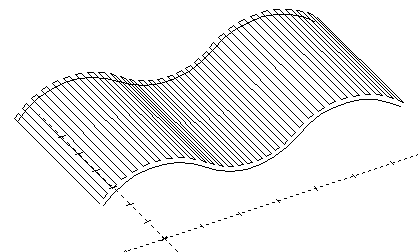anchor
Spectral Traces (pt. I)

The mysteries of a text are magnified within the circumscribed spaces of a building. A derridean reading of a text may not give us any sense as to the actual meaning of a word. And such a reading, when applied to a building, offers no additional insight. Yet there is a comfort in this mystery. Though Derrida argues that the meaning of a word is
ineffable, described by absences or suggestions (traces) of that meaning, this absence is ripe with possibilities. A more architectural reading (in fact, a wholly Eisenmanian reading) of a work will do the same. Derrida and Eisenman transfer the idea of
différance, the idea of a trace of a meaning, to architectural space when both argue about the meaning of the Platonic
choros. A
choros is a mute form (if a form can ever be so), and the architect, as a demiurge and formgiver, ascribes meaning to this form. He or she crafts it, molds it -- but this is not to suggest that the result of such formgiving is an actual, tangible physicality. The
choros is true ineffable space.
The use of the term
ineffable is not coincidental. Le Corbusier wrote of such ineffable spaces in
New World of Space (1948). In that book, Le Corbusier writes:
... the whole environment brings its weight to bear on the place where there is a work of art, the sign of man's will, and imposes on it its deep spaces or projections, its hard or soft densities, its violences or softnesses
Such poetic transcendence is evident in Le Corbusier's own Notre Dame du Haut at Ronchamp ... a place bounded by mystery if there ever was such a place.
The architectural critic and historian Robin Evans sought to decode of the latent, ineffable mysteries within Le Corbusier's chapel at Ronchamp. In "Comic Lines," the penultimate chapter in the posthumously published
The Projective Cast (1993), Evans answers Le Corbusier's challenge to find the modulor within the chapel's round, conch-like spaces. The modulor, Le Corbusier's hypnotic, baroque, and profound Fibonacci-inspired measurement system, defied the architect's own draftsmen. The modulor was literally transcribed on Le Corbusier's own buildings -- a glance at the lower storeys of his Unité d' Habitacion reveals the tell tale androgynous figure with arm stretched upwards. The demiurge has indeed written his own image into the
choros of the Unité.
The modulor operates as a glyph. But it is also a work of authorship, a mark or symbol that not only denotes authorial intent, but connotes a personal cosmography. For Evans, the modulor is not only concept carved in stone, but it is a presence that permeates the vaults at Romchamp. For what is Ronchamp if it is not a vaulted space? The sidereal vault hanging over our own heads at night is only repeated within the holy firmament inside Notre Dame du Haut. If the modulor is indeed authorial script, can its derridean traces be found in the system of
ruled surfaces along the chapel walls, floors and ceilings?

Ronchamp is an absent space. Evans reveals that any kind of mathematical logic related to the modulor's use is simply not there -- Le Corbusier handled any formal or mathematical issues in a cavalier way. Such matters were typically delegated to Le Corbusier's draftsmen and assistants, Evans tells us. In fact, it was Iannis Xenakis, one of Le Corbusier's assistant engineers/draftsmen, that used ruled surfaces to generate forms for the Monastery at La Tourette as well as the short-lived Philips Pavilion of 1958. Xenakis first used ruled surfaces as an alternate system of musical notation in a chamber orchestral piece entitled
Metastasis (1954). For Evans, a glance at that score reveals that
To coordinate 52 different string parts written for the orchestra ... Xenakis resorted to an unusual method of composition: he drew a graph. The horizontal axis represented time, the vertical axis represented pitch. The rising or falling sounds of each instrument were mapped onto the graph as straight lines. All together on the same sheet they give a picture of total orchestral sound, much more directly apprehensible than in conventional musical notation ... these were referred to by Xenakis as "ruled surfaces of sound" to be continued ....
to be continued ....






4 Comments
What?! Xenakis worked for Corb?!
Yes ... on several different projects.
you bet...and he is the only employee of corbs to have been given any title of authorship on a corb project.
xenakis is a completely fascinating figure of the 20th century..keep it up smss!
and then we went on to design the philips pavillion

Block this user
Are you sure you want to block this user and hide all related comments throughout the site?
Archinect
This is your first comment on Archinect. Your comment will be visible once approved.